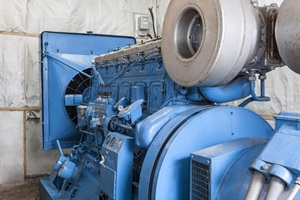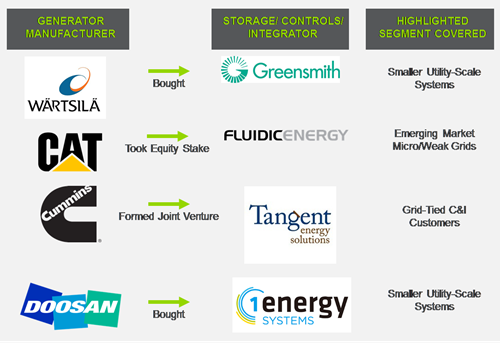- Genset Manufacturers
- HybridStorage
- Energy Technologies
- Energy Technologies
- Mergers Acquisitions
- Energy Cloud
Wärtsilä Acquires Greensmith: Genset Manufacturers Expand Their Role in the Energy Cloud

This week, Wärtsilä announced its acquisition of Greensmith, highlighting a significant trend: generator set (genset) manufacturers are acquiring systems integration and controls capabilities. As this trend continues, the companies are embedding themselves ever deeper into the distributed energy paradigm outlined in Guidehouse’s Energy Cloud.
Hybrid/Storage Plays
Wärtsilä of Finland is a major global producer of larger reciprocating engines for power generation and marine uses. Yet, genset manufacturers in a variety of segments have been building relationships with storage and controls companies. This strategy can be considered both defensive and offensive in the fast changing genset industry, as explained below. Some specific moves since 2015 are shown in the following figure.
Generator Manufacturers with Publicly Announced Hybrid/Storage Plays

(Sources: Guidehouse Insights, Company Press Releases)
In addition to Cummins, Caterpillar, Wärtsilä, and Doosan, other generator manufacturers, including General Electric (GE) and Aggreko, have announced storage offerings developed either internally or by undisclosed vendors. Most of the above companies also offer solar PV solutions in conjunction with their installations, whether through partners, through distributors, or directly.
There is clear appeal in genset/storage/PV hybrid systems. PV provides clean daytime power at cheapening costs, while gensets provide flexible baseload on demand for nighttime hours and fluctuations in demand. Solar production forecasting, as in the cloud monitoring systems developed by CSIRO, can adjust the operation of gensets to improve integration and save fuel costs (often a significant few percentage points). Storage then provides multiple benefits: in addition to smoothing out PV production, batteries can optimize genset operation, allowing for fuel savings, smoother operation, and sometimes even elimination of redundant gensets.
Defense and Offense
With the latter fact in mind, this acquisition/partnering strategy can be thought of as playing defense—acquiring a backfill revenue source for what may be a declining need for number of systems on any given project. Consider the example presented by Wärtsilä here. Of the six gensets in the “spinning reserve by engine vs storage comparison,” two have become redundant with the addition of battery storage, since the storage provides the spinning reserve formerly afforded by the gensets. If vendors see lower genset sales in cases like these, they may jump at the chance to backfill with sales of controls, storage, or PV.
Apart from its defensive aspects, this strategy also has significant offensive upside. As power production becomes ever more decentralized, genset manufacturers with solid distributed energy resources (DER) strategies will be well positioned to capture market share. There exist major opportunities in microgrids and virtual power plants—indeed, all across the Energy Cloud. As the core technology providers of thousands of legacy microgrids, genset vendors are both driven and well suited to serve a major role in the future of electricity.